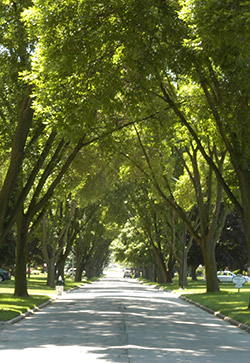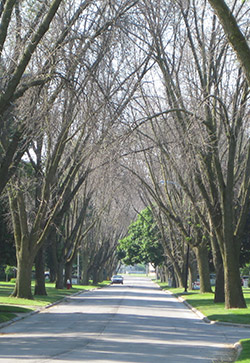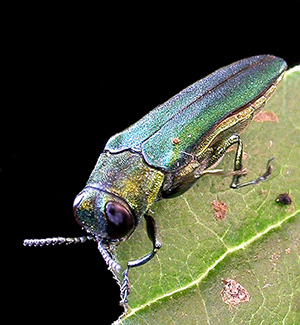Will We Kiss Our Ash Goodbye?
American Forests, Winter 2013
An ecological catastrophe is unfolding across the upper Midwest and is spreading outward, as scientists struggle to find solutions to the latest insect invasion: emerald ash borer.
By Dr. Deborah G. McCullough
 |
| Ash trees in a Toledo, Ohio neighborhood in June 2006. Credit: D. Herms |
 |
| Toledo, Ohio trees after emerald ash borer in August 2009. Credit: D. Herms. |
It’s not like we haven’t seen this sort of thing before. In the early 1900s, people who lived in the eastern U.S. watched chestnut blight, an exotic pathogen, roll through, killing large and small trees and altering the hardwood forest forever. A few decades later, Dutch elm disease, an exotic pathogen carried by an exotic bark beetle, came through, killing majestic American elms along city streets and in forests. Today, more than 450 species of nonnative forest insects and at least 17 significant forest pathogens are established in the U.S. Most go unnoticed, but about 15 percent have had major consequences. And it’s starting again.
Emerald ash borer, an Asian insect first identified in Detroit, Mich., in 2002, has become the most destructive forest insect to ever invade the U.S. Tens of millions of ash trees have already been killed in forests and swamps, along waterways and in urban, suburban and rural neighborhoods. Populations of emerald ash borer, commonly known as EAB, have been found in 18 states, along with Ontario and Quebec. And almost assuredly, there are more populations, simmering away, that haven’t yet been discovered.
BEAUTIFUL KILLERS
 |
| An adult emerald ash borer feeding on a leaf. Credit: David Cappaert. |
Once EAB populations begin to build, nearly all ash trees in the forest, swamp or urban area are likely to become infested and die — often within a time span of only a few years. Read more....








0 comments:
Post a Comment